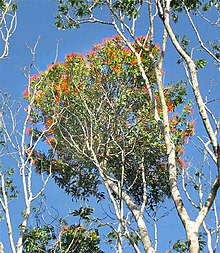
Back إسارية Arabic اساريه ARZ Loranthaceae AST Boğambürckimilər Azerbaijani Рэменякветкавыя Byelorussian Loranthaceae BS Lorantàcies Catalan Loranthaceae CEB Ochmetovité Czech Riemenblumengewächse German
| Loranthaceae | |
|---|---|

| |
| Ligaria cuneifolia | |
| Scientific classification | |
| Kingdom: | Plantae |
| Clade: | Tracheophytes |
| Clade: | Angiosperms |
| Clade: | Eudicots |
| Order: | Santalales |
| Family: | Loranthaceae Juss.[1] |
| Genera | |
|
See text | |

| |
| Distribution of the Loranthaceae. | |

Loranthaceae, commonly known as the showy mistletoes, is a family of flowering plants.[2][3] It consists of about 75 genera and 1,000 species of woody plants, many of them hemiparasites. The three terrestrial species are Nuytsia floribunda (the Western Australian Christmas tree), Atkinsonia ligustrina (from the Blue Mountains of Australia), and Gaiadendron punctatum (from Central/South America.) Loranthaceae are primarily xylem parasites, but their haustoria may sometimes tap the phloem,[4] while Tristerix aphyllus is almost holoparasitic.[5] For a more complete description of the Australian Loranthaceae, see Flora of Australia online Archived 2018-04-01 at the Wayback Machine.,[2] for the Malesian Loranthaceae see Flora of Malesia.
Originally, Loranthaceae contained all mistletoe species, but the mistletoes of Europe and North America (Viscum, Arceuthobium, and Phoradendron) belong to the family Santalaceae. The APG II system 2003 assigns the family to the order Santalales in the clade core eudicots.
- ^ Angiosperm Phylogeny Group (2009). "An update of the Angiosperm Phylogeny Group classification for the orders and families of flowering plants: APG III". Botanical Journal of the Linnean Society. 161 (2): 105–121. doi:10.1111/j.1095-8339.2009.00996.x. hdl:10654/18083.
- ^ a b Cite error: The named reference
FoAOwas invoked but never defined (see the help page). - ^ Kuijt, Job; Hansen, Bertel (2015). Flowering Plants. Eudicots. Santalales, Balanophorales. Cham: Springer International Publishing. doi:10.1007/978-3-319-09296-6. ISBN 978-3-319-09295-9. S2CID 35096693.
- ^ Cite error: The named reference
Barlow1997was invoked but never defined (see the help page). - ^ Cite error: The named reference
Stevenswas invoked but never defined (see the help page).